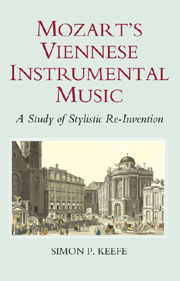Book contents
- Frontmatter
- Contents
- List of Musical Examples
- List of Figures
- For Celia, Abraham and Madeleine
- Acknowledgements
- Introduction: Mozart and Stylistic Re-Invention
- I PIANO CONCERTOS
- II STRING QUARTETS
- 4 An Integrated ‘Dissonance’: Mozart's ‘Haydn’ Quartets and the Slow Introduction of K. 465
- 5 Mozart's ‘Prussian’ Quartets, K. 575, 589 and 590: Towards a New Aesthetic of the String Quartet
- III SYMPHONIES
- IV CONCLUSIONS
- Bibliography
- Index of Mozart's Works by Köchel Number
- Index of Mozart's Works by Genre
- General Index
4 - An Integrated ‘Dissonance’: Mozart's ‘Haydn’ Quartets and the Slow Introduction of K. 465
from II - STRING QUARTETS
Published online by Cambridge University Press: 05 September 2013
- Frontmatter
- Contents
- List of Musical Examples
- List of Figures
- For Celia, Abraham and Madeleine
- Acknowledgements
- Introduction: Mozart and Stylistic Re-Invention
- I PIANO CONCERTOS
- II STRING QUARTETS
- 4 An Integrated ‘Dissonance’: Mozart's ‘Haydn’ Quartets and the Slow Introduction of K. 465
- 5 Mozart's ‘Prussian’ Quartets, K. 575, 589 and 590: Towards a New Aesthetic of the String Quartet
- III SYMPHONIES
- IV CONCLUSIONS
- Bibliography
- Index of Mozart's Works by Köchel Number
- Index of Mozart's Works by Genre
- General Index
Summary
EVER since their completion and publication in 1785, Mozart's six string rquartets dedicated to Haydn, K. 387 in G, K. 421 in D minor, K. 428 in Eb, K. 458 in Bb, Kb. 464 in A and K. 465 in C, have elicited strong reactions from musicians and critics alike. The private performance of the last three works of the set with Mozart and Leopold in Vienna on Saturday 12 February 1785, less than a month after Mozart had finished K. 465, prompts Haydn's famous proclamation to Leopold: ‘Before God and as an honest man I tell you that your son is the greatest composer known to me either in person or by name. He has taste and, what is more, the most profound knowledge of composition.’ The remarkable technical proficiency of these works is echoed shortly thereafter by the theorist Heinrich Christoph Koch, who admires ‘their special mixture of the strict and free styles and the treatment of harmony’ and by Mozart's first biographer Franz Xaver Niemetschek who identifies ‘a treasure-house of the finest thoughts, and a model and example of the art of composition’ in which everything ‘is carefully considered and perfected’. But praise for the ‘Haydn’ quartets was by no means universal in the years following their publication.
- Type
- Chapter
- Information
- Mozart's Viennese Instrumental MusicA Study of Stylistic Re-Invention, pp. 89 - 104Publisher: Boydell & BrewerPrint publication year: 2007



